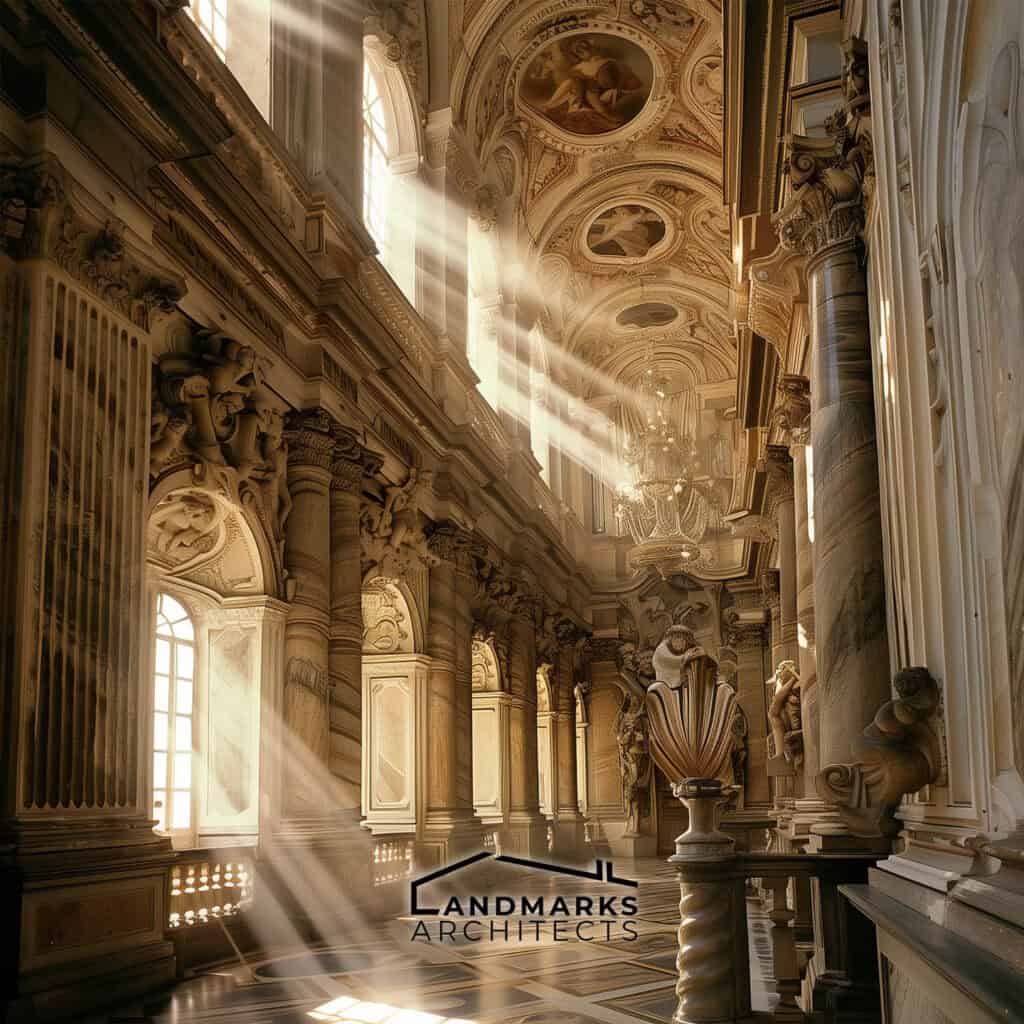
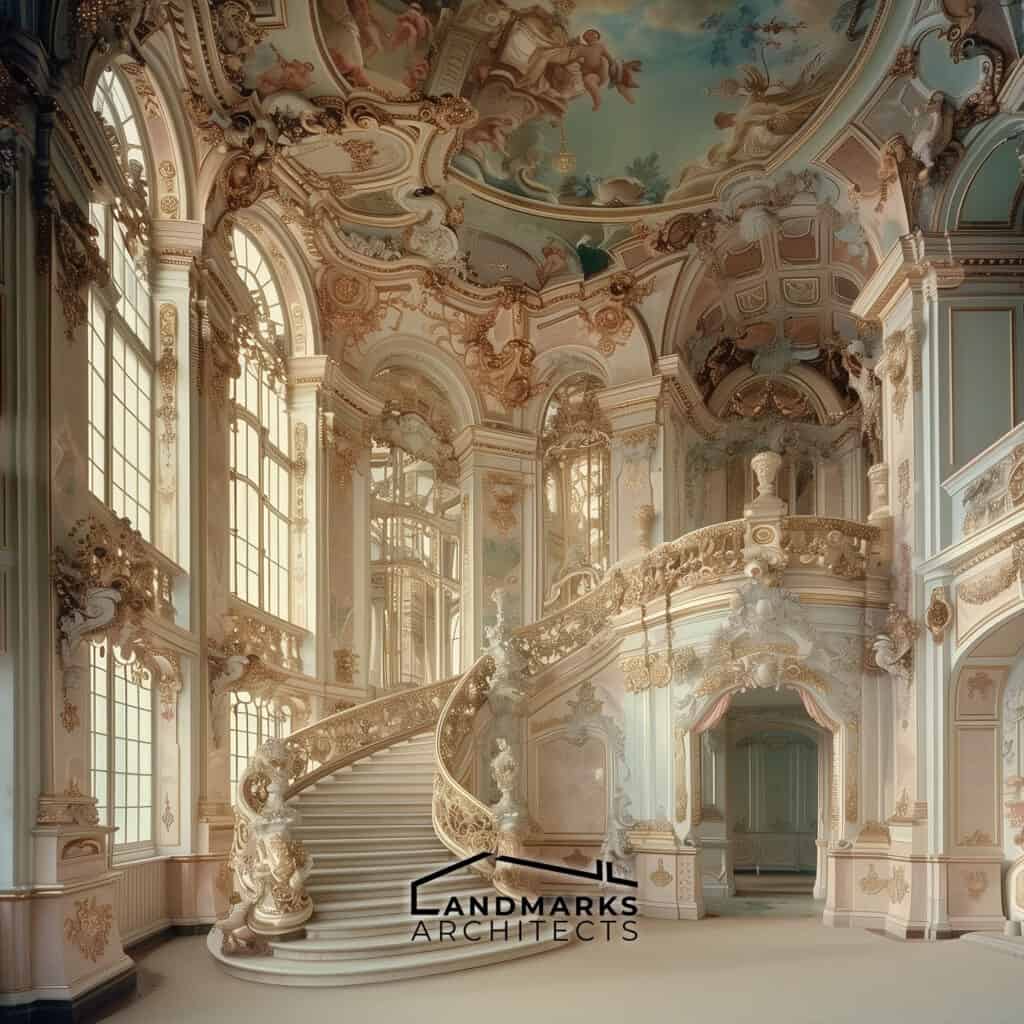
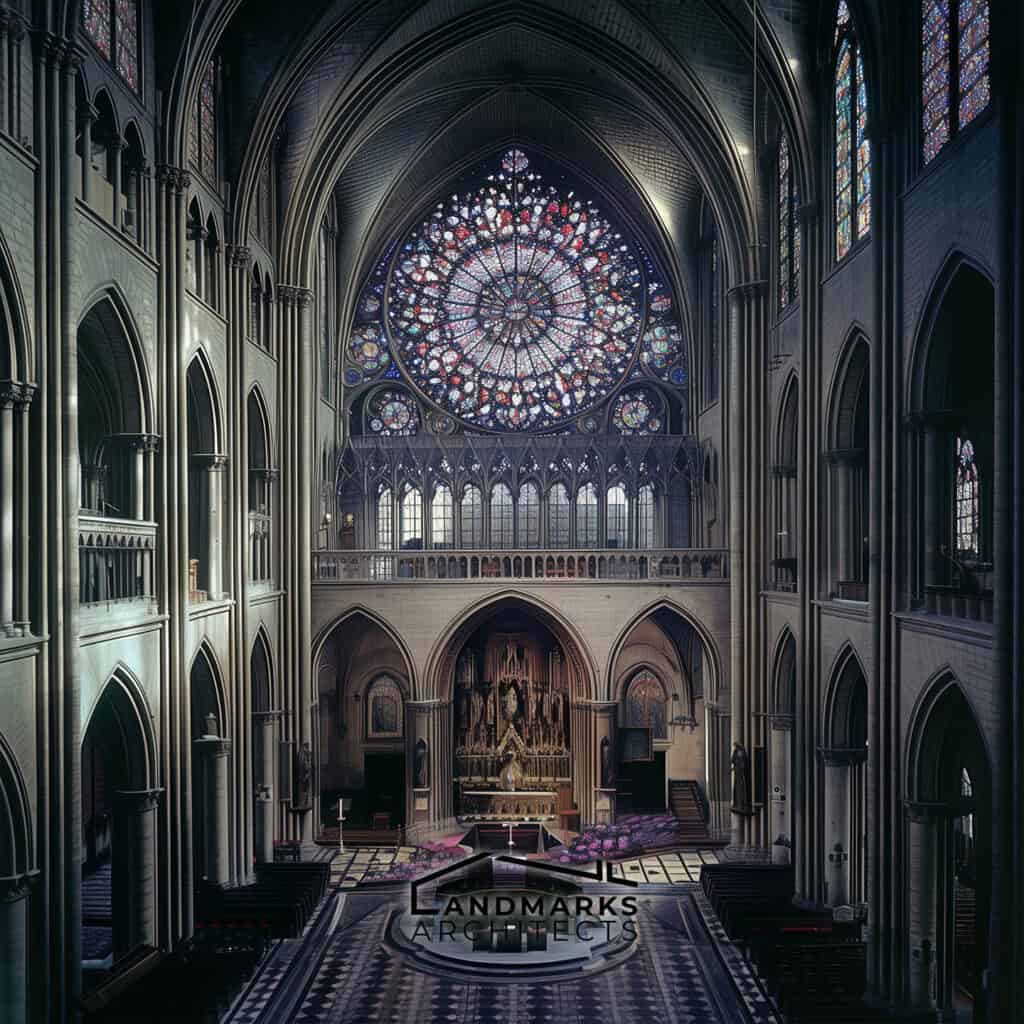
Are you fascinated by the diverse and rich history of European architecture? As a history enthusiast or an aspiring architect, you deserve to explore how these styles have evolved over centuries, shaping the world around us. The journey through European-style architecture can be intricate, but it’s a rewarding adventure filled with timeless beauty and innovation.
At Landmarks Architects, we understand the significance of these architectural styles in influencing contemporary design. With extensive experience in architectural history, we’re here to guide you through the fascinating evolution of European architecture.
In this article, we will cover:
- Ancient and Classical Architecture: The foundations of European design
- Medieval Architecture: The emergence of Romanesque and Gothic styles
- Renaissance Architecture: A revival of classical principles
- Baroque to Rococo: The height of ornamental design
- Neoclassical to Art Nouveau: The return to classical simplicity and the embrace of nature
- Modernism and Bauhaus: The birth of functional design
- Post-War and Contemporary Architecture: Brutalism and Deconstructivism
Are you ready to explore the rich panorama of European architectural history? Continue reading to discover how these styles have shaped our built environment and continue to influence modern design.
Ancient and Classical Architecture Styles
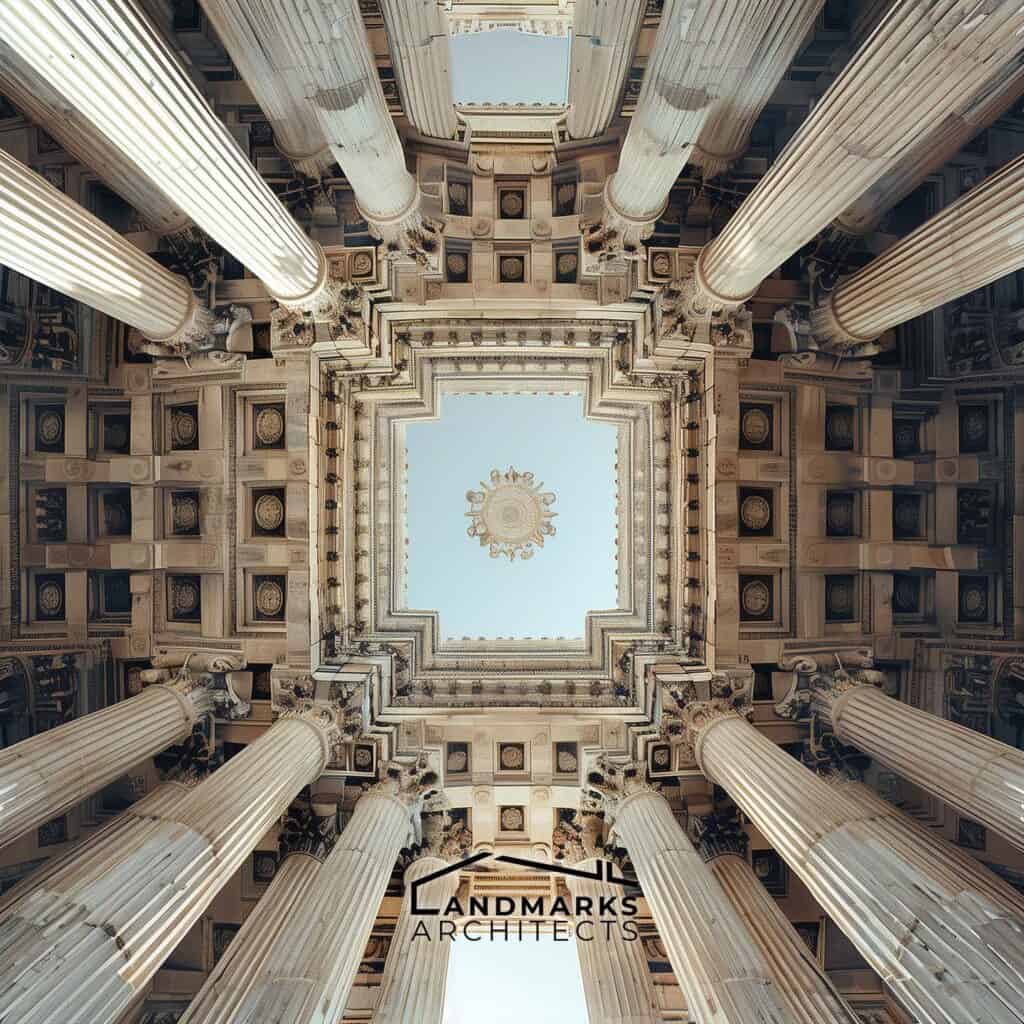
Ancient and Classical Architecture refers to the architectural styles of ancient Greece and Rome. These styles have been influential in the development of European-style architecture, as well as other architectural styles around the world. Particularly influenced by Greek and Roman styles, these architectural forms were more common in cities across Southern Europe, with Rome being the most prominent example.
1. Greek Architecture

Greek Architecture Greek architecture is known for its columns: Doric, Ionic, and Corinthian. Buildings were often constructed from marble and featured pediments, friezes, and metopes. This style influenced Roman architecture.
Characteristics:
- Use of columns, particularly the Doric, Ionic, and Corinthian orders
- Marble construction
- Pediments, friezes, and metopes
- Focused on proportionality and harmony
Famous Example: The Parthenon in Athens, Greece
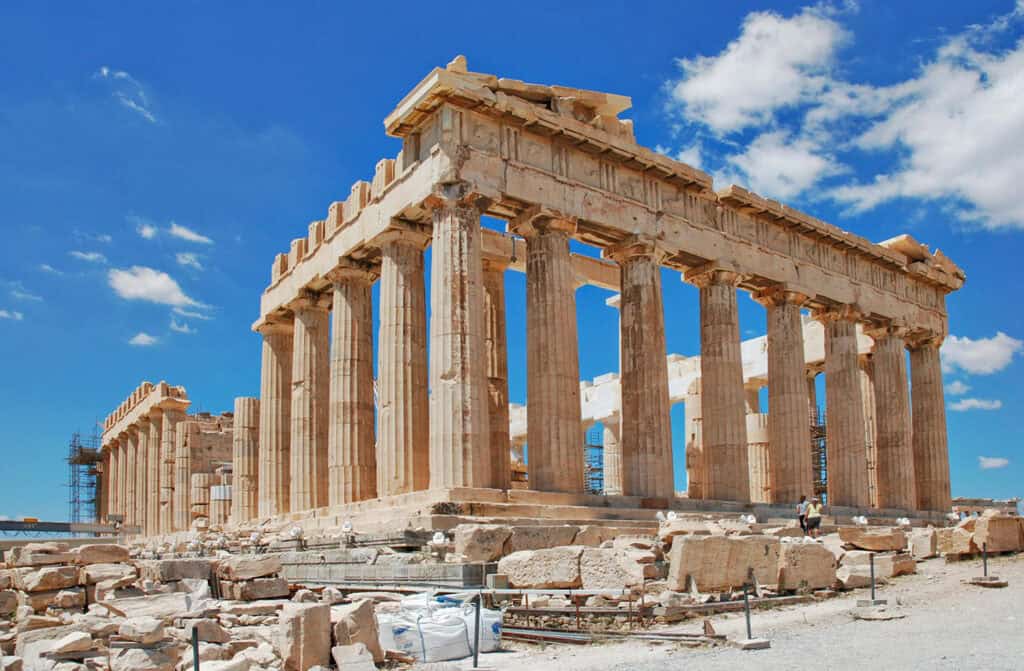
2. Roman Architecture

Roman Architecture Roman architecture is defined by arches, vaults, and domes. Using concrete, Romans built structures with barrel vaults, groin vaults, and coffered ceilings. This style greatly influenced European architecture.
Characteristics:
- Use of arches, vaults, and domes
- Concrete construction
- Barrel vaults, groin vaults, and coffered ceilings
- Roman architecture integrated engineering innovations like aqueducts and extensive road networks
Famous Example: The Colosseum in Rome, Italy

3. Byzantine Architecture

Byzantine architecture, dominant from 330 AD to 1453 AD, is known for its domes, vaults, arches, and extensive use of mosaics. It was more common in cities across Eastern Europe, with Constantinople (modern-day Istanbul) being the most prominent example.
Characteristics :
- Use of domes, vaults, and arches
- Use of mosaics for decoration
- Use of marble and other precious materials
- Emphasis on the interior of buildings
Famous Examples:
Hagia Sophia in Istanbul: Built in the 6th century, it served as a church, then a mosque, and is now a museum.
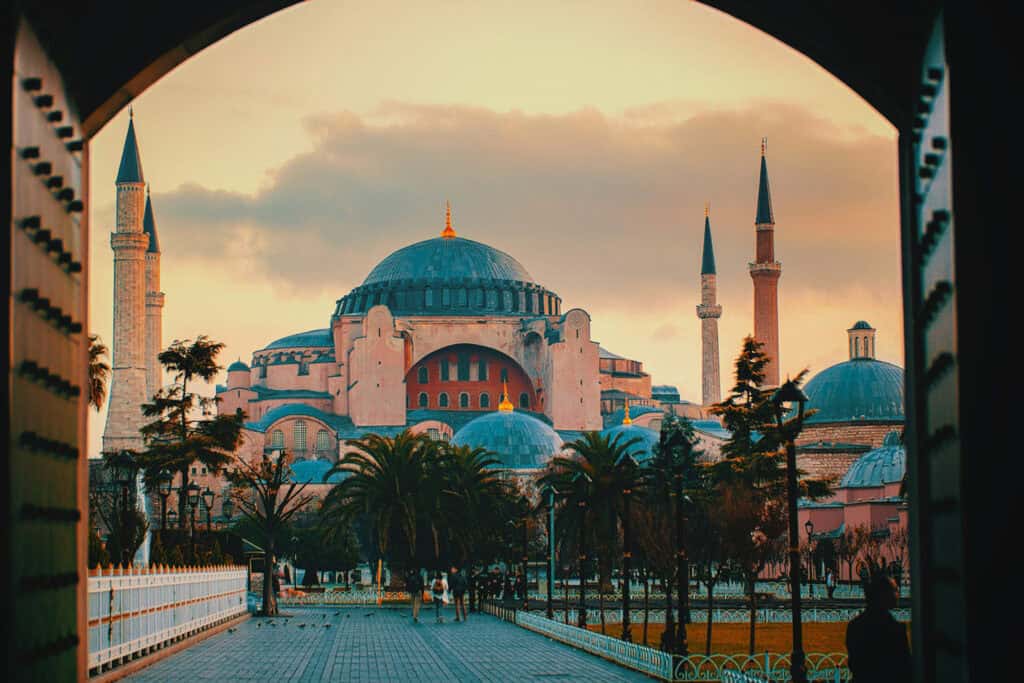
Church of San Vitale in Ravenna: Also built in the 6th century, it is renowned for its intricate mosaics.
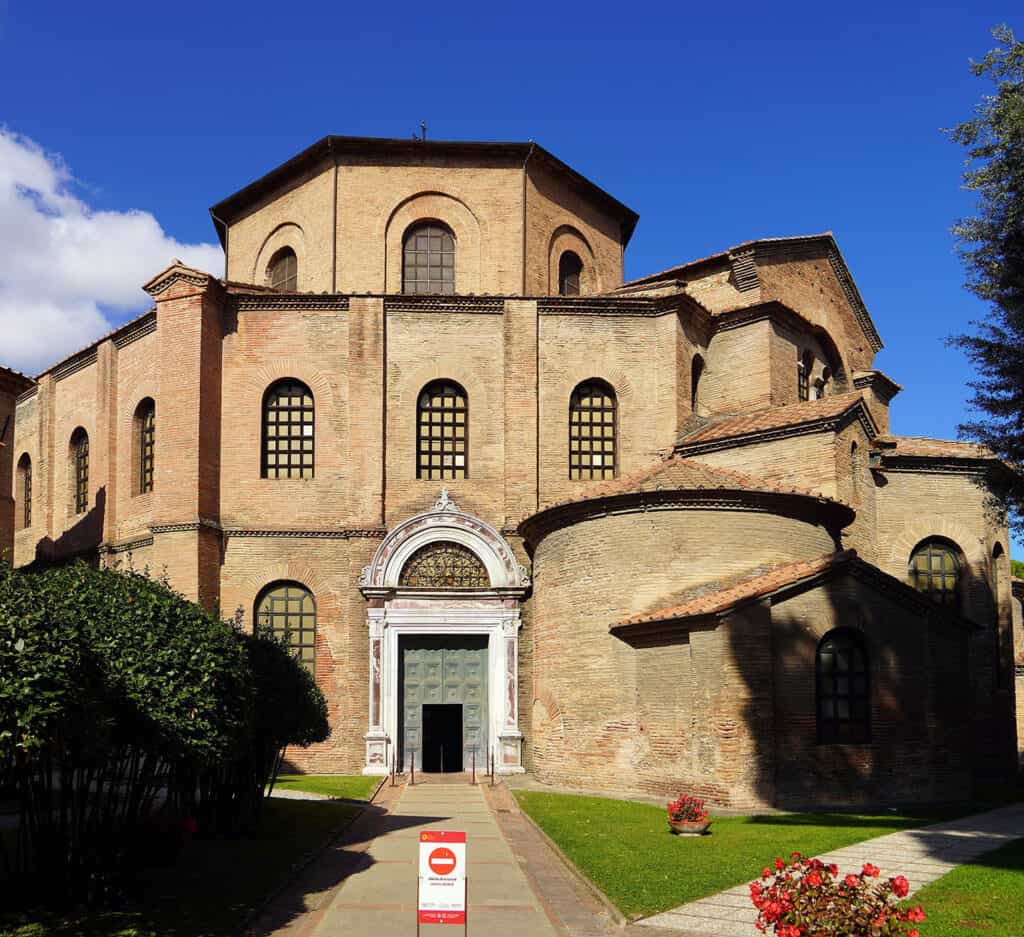
Byzantine architecture significantly influenced medieval and Renaissance architecture, especially through its innovative use of domes, vaults, and arches.
Medieval Architecture Styles
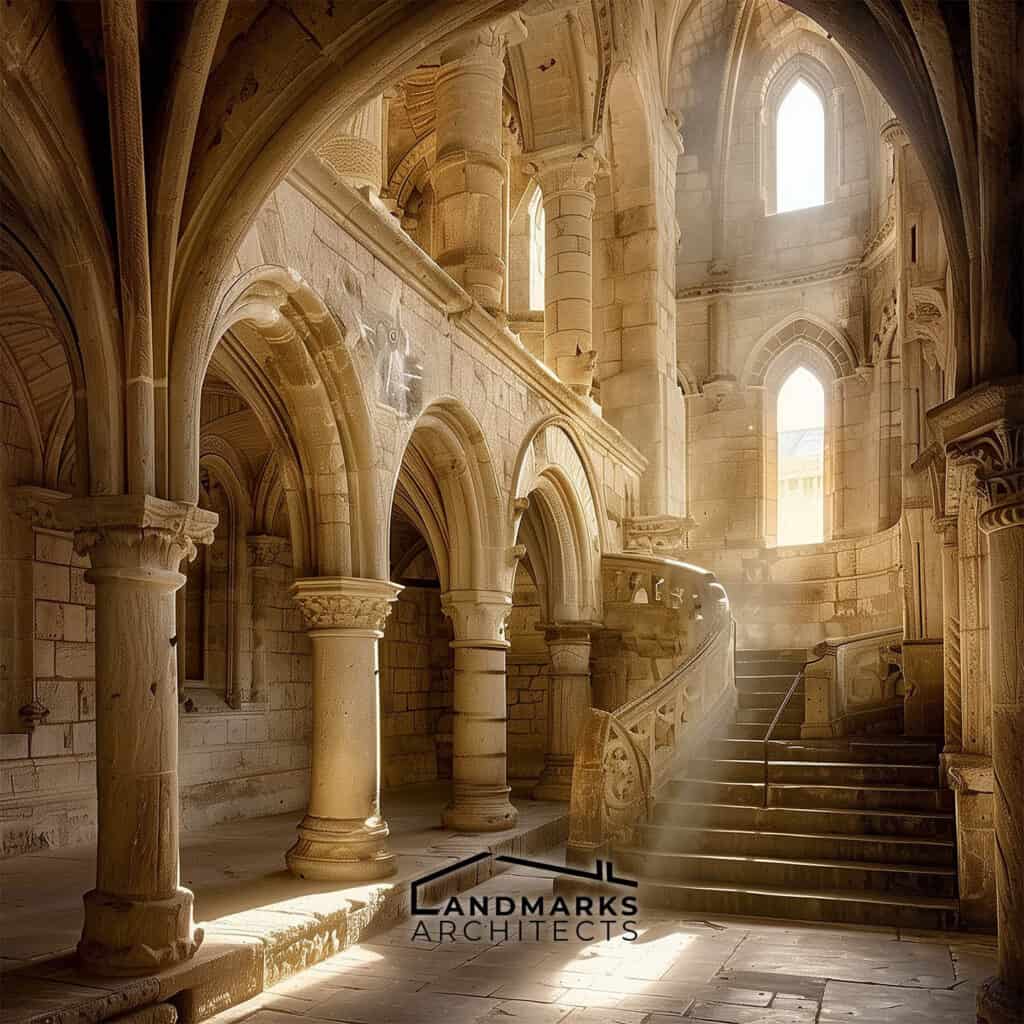
During the Middle Ages, European architecture saw the emergence of several styles, with Romanesque and Gothic being the most prominent. Medieval architecture was more common in cities across Western Europe, with Paris being one of the most significant examples of this style.
4. Romanesque Architecture
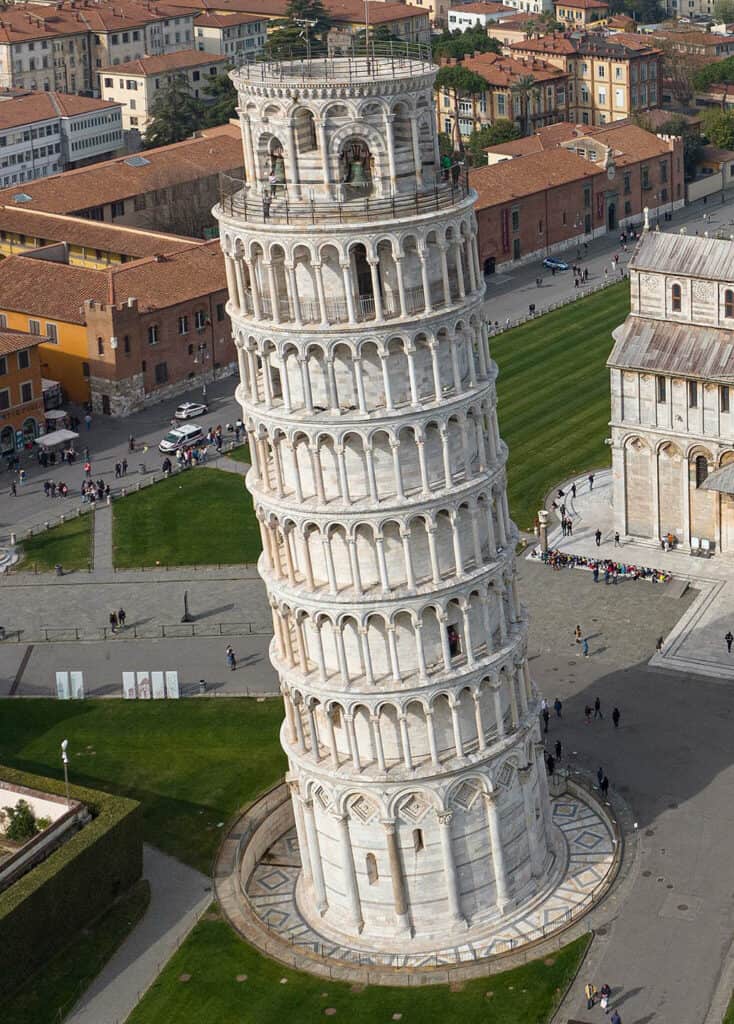
Romanesque architecture emerged in Europe during the 11th and 12th centuries. The buildings were designed to be imposing and fortress-like, reflecting the turbulent times of the Middle Ages. Romanesque Architecture was more common in cities across Western Europe.
Characteristics :
- Semi-circular arches
- Barrel and groin vaults
- Thick walls
- Sturdy pillars
- Rounded arches
- Decorative arcading
- emphasizing the fortress-like qualities due to the need for defense during turbulent times
Famous Examples:
- Basilica of Saint Sernin (Toulouse, France): It is renowned for its imposing bell towers, intricate stone carvings, and impressive nave. The basilica serves as a significant pilgrimage site and stands as a testament to medieval architectural excellence in Southern France.
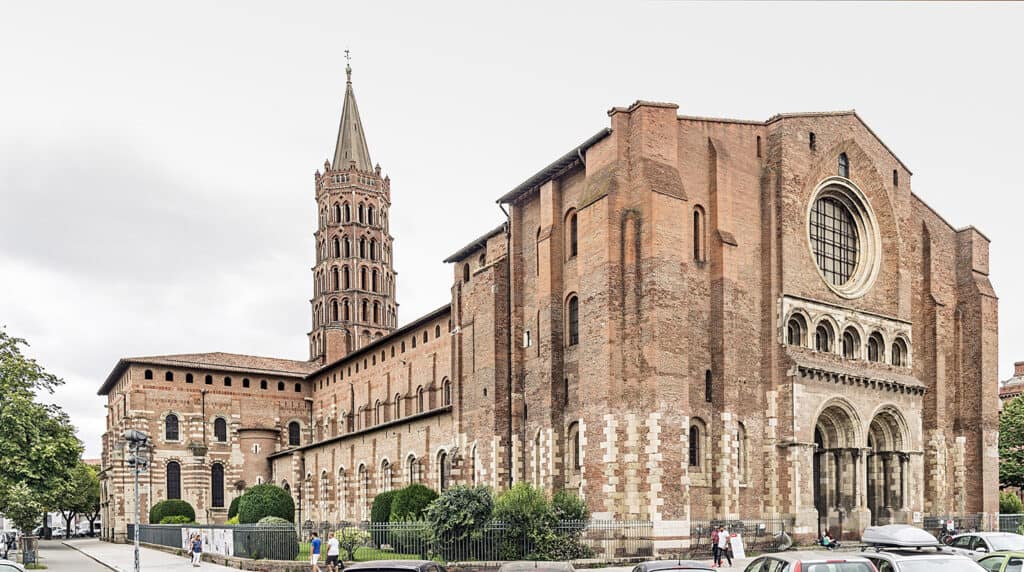
- Santiago de Compostela (Spain): This cathedral is a pilgrimage destination and a prime example of Romanesque architecture, featuring thick walls, semi-circular arches, and a monumental presence that reflects its importance in medieval Europe.
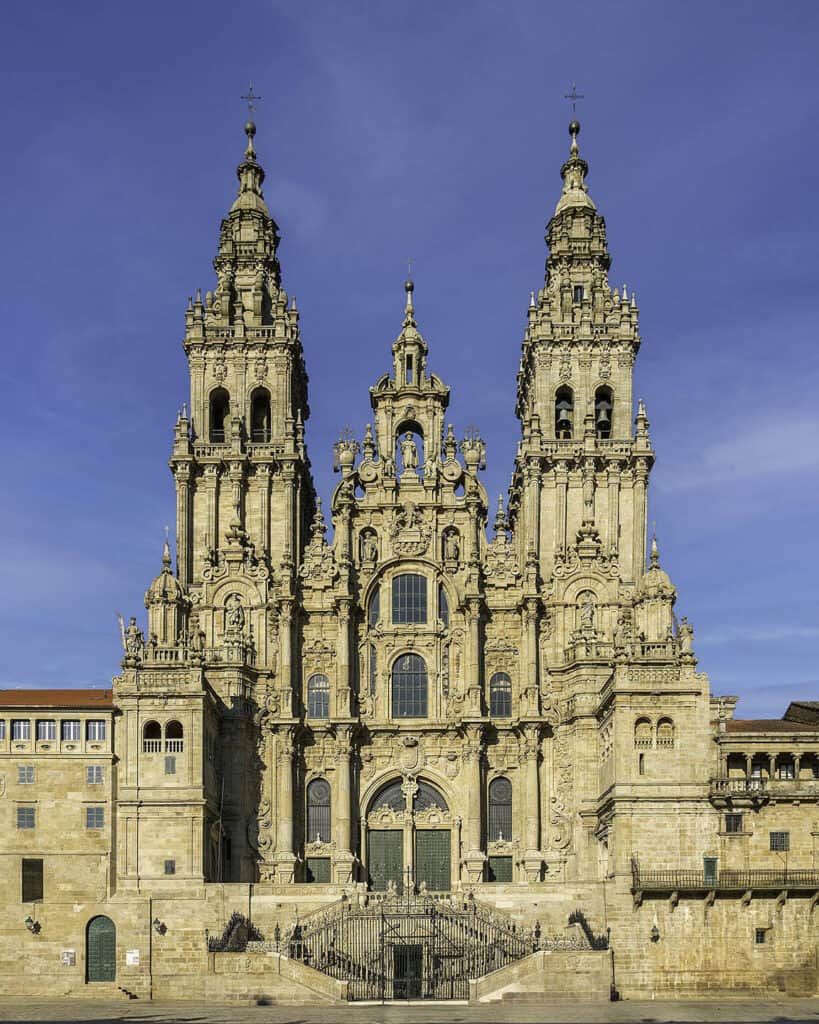
5. Gothic Architecture
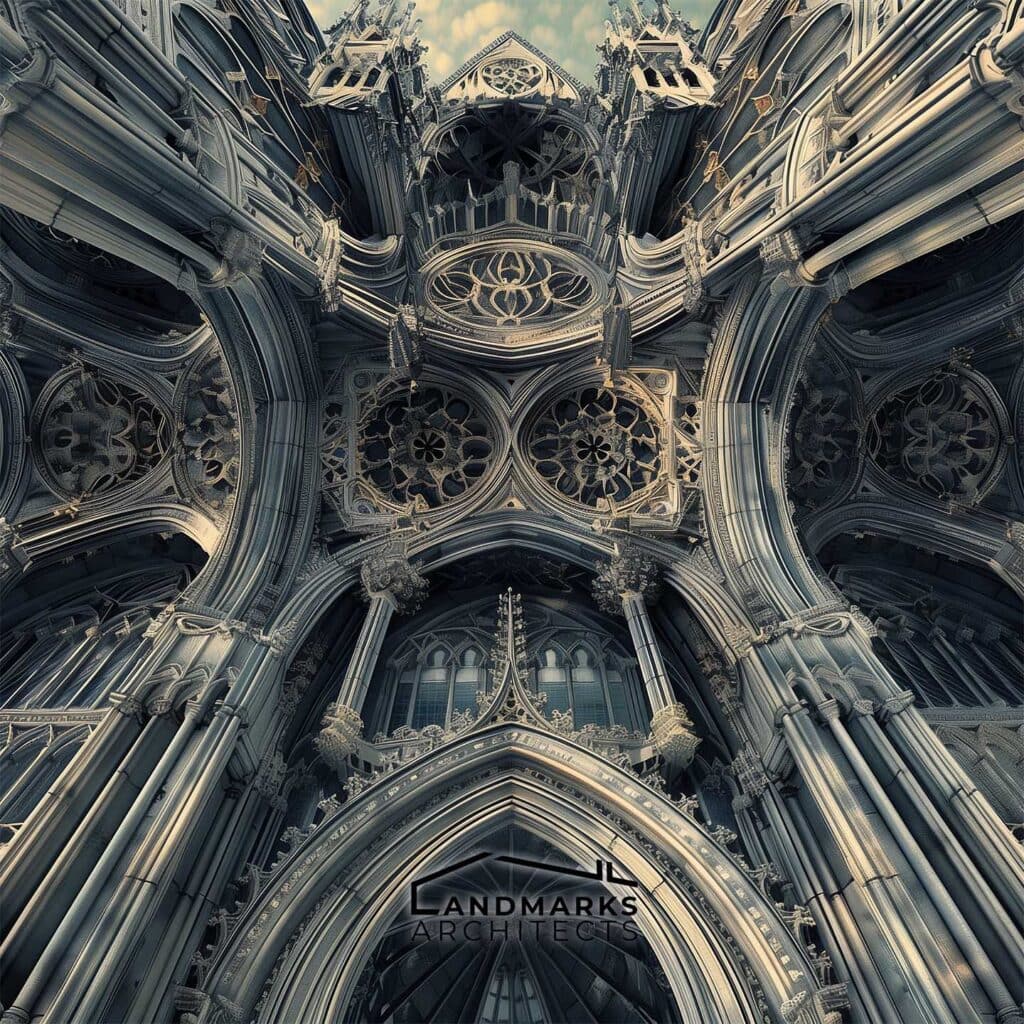
Gothic architecture was more common in cities across Western Europe during the 12th to 16th centuries.
Characteristics :
- Pointed arches
- Ribbed vaults
- Flying buttresses
- Stained glass windows
- Decorative tracery
- Rose windows
- The focus on verticality and light was meant to inspire awe and spiritual upliftment
Famous Examples:
- Notre Dame Cathedral in Paris, France exemplifies Gothic architecture with its soaring spires, intricate sculptures, and stunning stained-glass windows

- Cologne Cathedral, Germany is a quintessential example of Gothic architecture, renowned for its towering twin spires and elaborate façade.
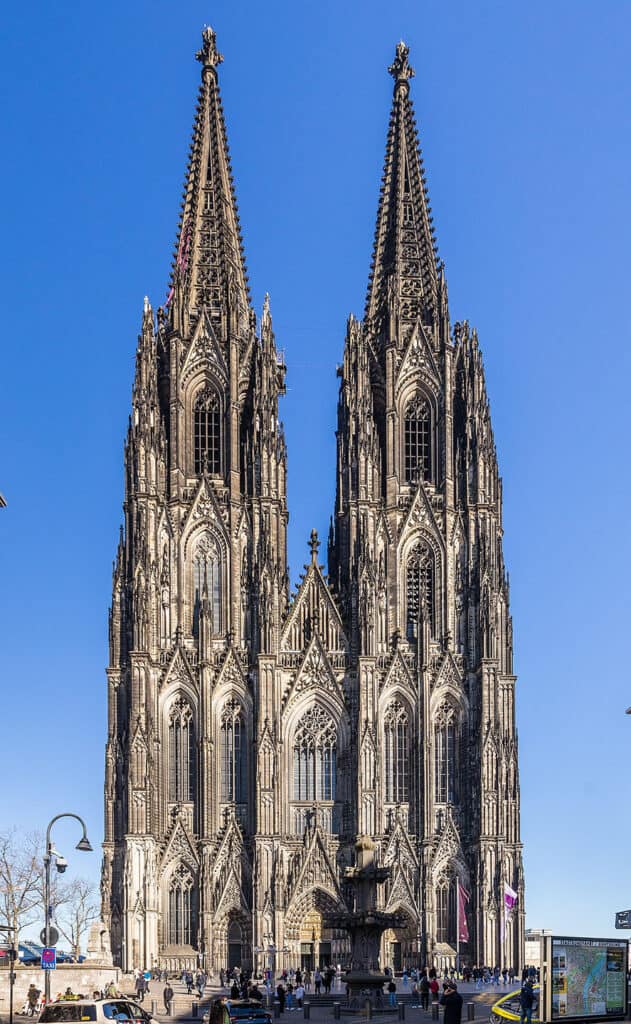
Medieval architecture significantly influenced Western building styles, with the Catholic Church as a major patron. Many medieval buildings remain popular tourist attractions today.
6. Renaissance Architecture

Renaissance architecture, emerging in early 15th-century Italy, marked a shift from the Gothic style and revived ancient Roman forms like columns and round arches. This style spread across Europe, influencing many iconic structures. Renaissance architecture also revived humanist ideals and sought to reflect the harmony of the cosmos in its proportions. Renaissance Architecture was indeed more common in cities across Italy.
Characteristics :
- Symmetry and proportion
- Use of classical orders (Doric, Ionic, Corinthian)
- Pilasters, pediments, and cornices
- Domes and arches
- Emphasis on mathematical precision
Famous Examples:
- Florence Cathedral: or the Cathedral of Santa Maria del Fiore, is a renowned example of Renaissance architecture, featuring the iconic dome designed by Filippo Brunelleschi.
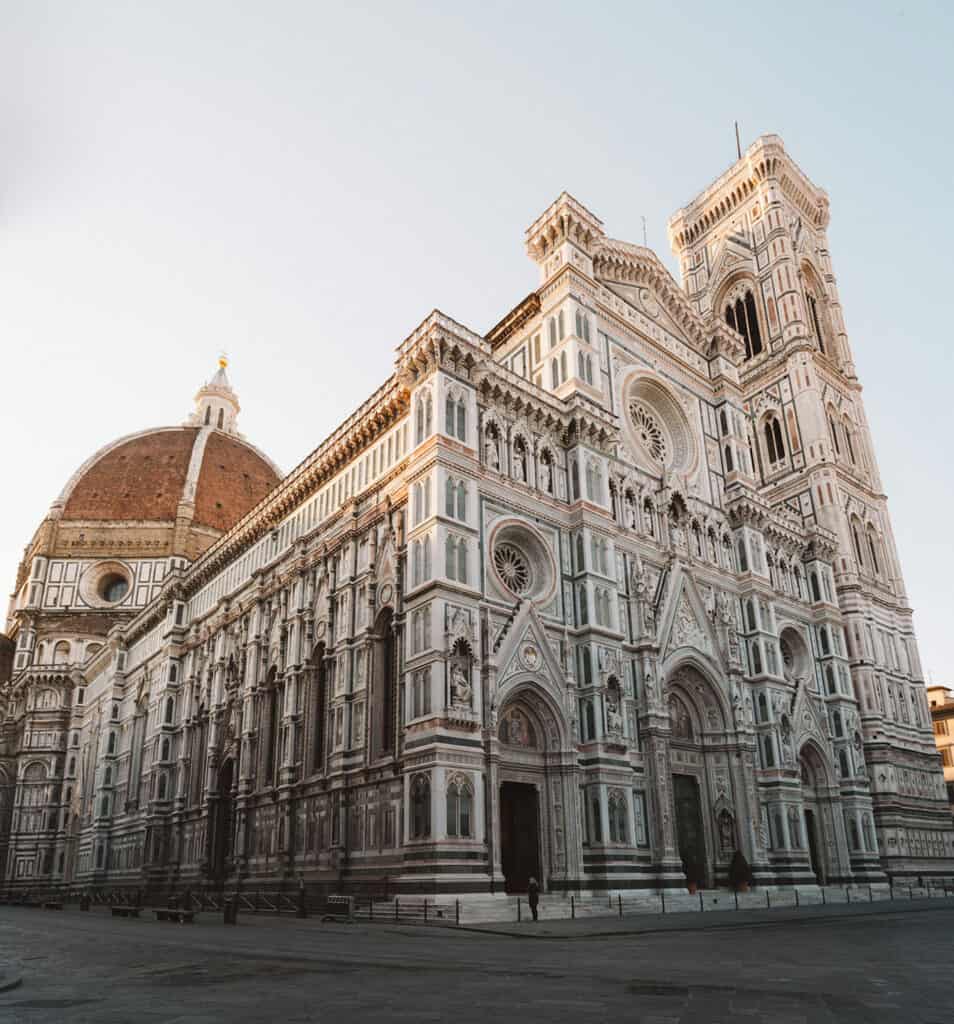
- St. Peter’s Basilica in Vatican City: is a masterpiece of Renaissance architecture, notable for its grand dome and harmonious proportions.

One of the most significant events in the history of Renaissance architecture was the Protestant Reformation, which led to a diversification of architectural styles and the repurposing of many Catholic churches. Renaissance architecture greatly influenced the development of European architectural styles, emphasizing mathematical precision and classical orders, which paved the way for Baroque and Neoclassical architecture.
7. Baroque Architecture
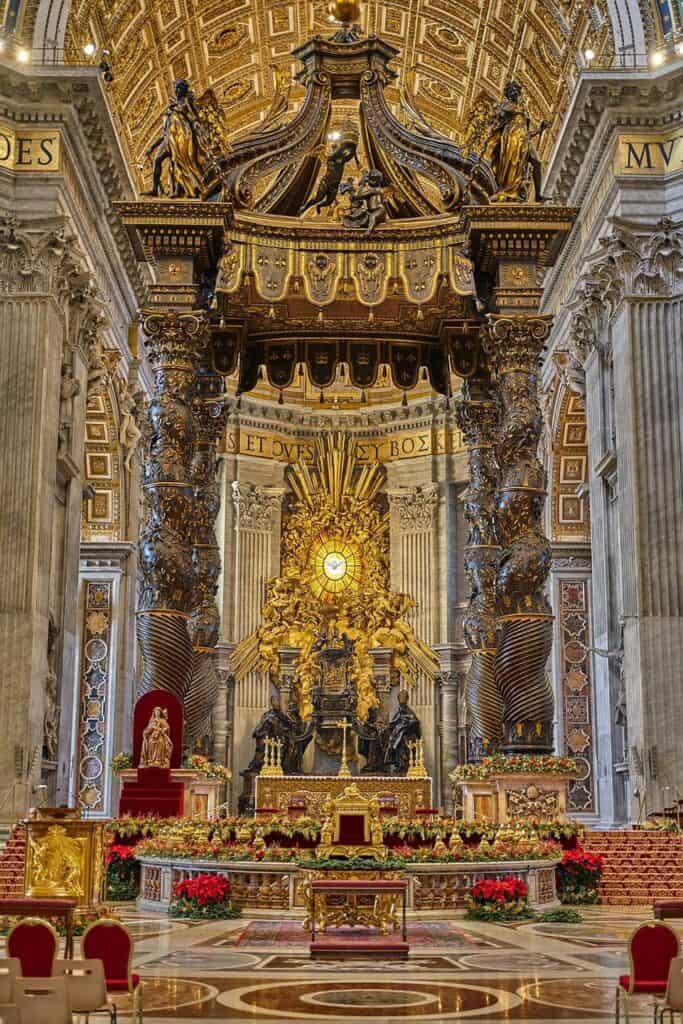
Baroque architecture, originating in late 16th-century Italy and spreading across Europe, is known for its dramatic and ornate style, rooted in the Counter-Reformation’s emotional appeal. It was particularly prominent in cities across Western and Central Europe. One of the most significant cities associated with Baroque architecture is Rome, Italy.
Characteristics :
- Ornate details and decorations
- Curved shapes and lines
- Large-scale decoration
- Dramatic effects of light and shadow
- Use of vivid colors
- Elaborate ceiling frescoes
- The use of oval shapes and dynamic movement was meant to evoke emotional responses
Famous Examples:
- The Palace of Versailles in France: is a prime example of Baroque architecture, characterized by its opulent ornamentation, expansive gardens, and grandiose design.

Baroque architecture transcended Europe, influencing religious buildings in South America. It remains a testament to grandeur, elaborate decoration, and dramatic expression.
See Also Baroque Style: 61 Fascinating Facts
8. Rococo Architecture

Rococo architecture, flourishing in 18th-century Europe, is known for its ornate and flamboyant style, featuring rocaille motifs and classical elements. It was particularly prominent in cities across Western and Central Europe, with Paris, France, standing out as one of the most significant centers of Rococo architecture.
Characteristics :
- Elaborate and theatrical presentations
- Use of light and pastel colors
- Emphasis on asymmetry and curved lines
- Ornate decoration with shells, flowers, and other natural motifs
- Use of mirrors to create an illusion of space
- Focus on interior design and decoration
- Emphasizing a playful and light-hearted elegance
Famous Example:
- Amalienburg in Munich, Germany: showcases Rococo architecture through its elegant curves, elaborate stuccowork, and playful ornamentation.
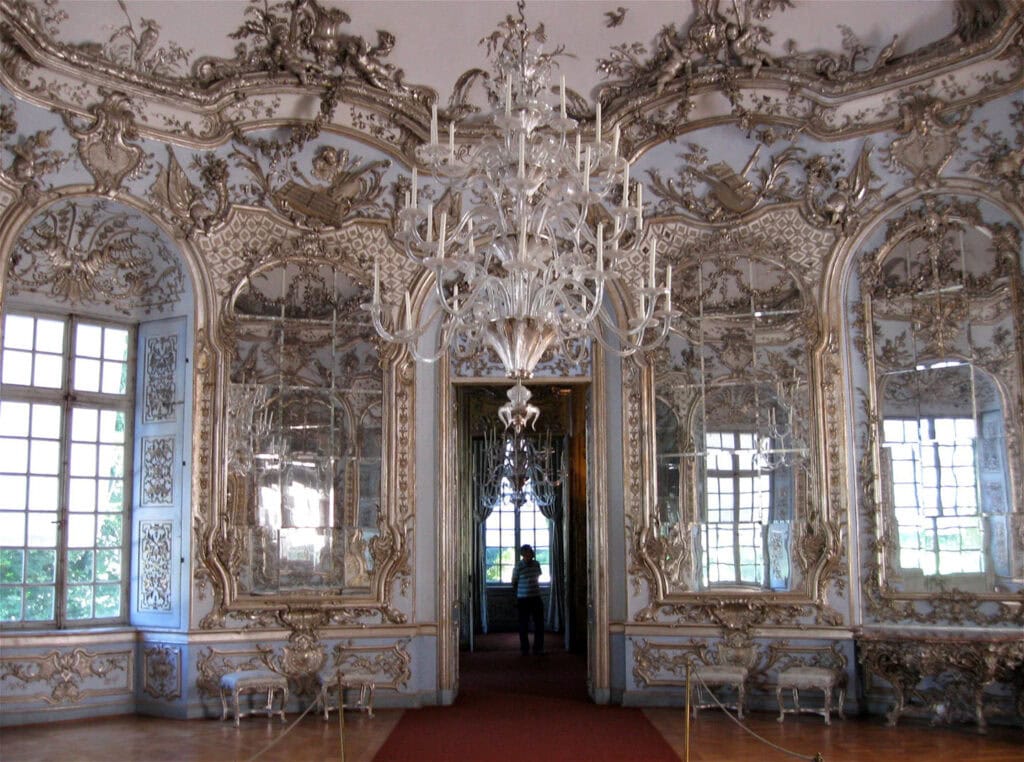
- The Hôtel de Soubise in Paris, France: is a prominent example of Rococo architecture, characterized by its intricate stuccowork, delicate ornamentation, and emphasis on asymmetry and lightness.
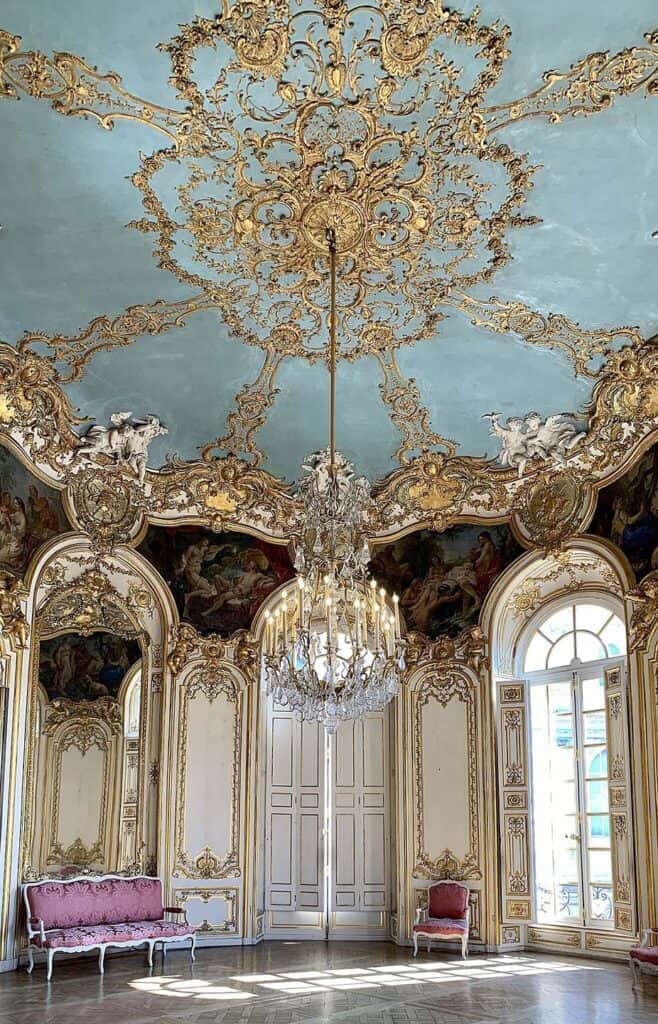
Rococo architecture left a significant mark on European society, influencing various buildings such as town halls, bell towers, and concert halls. Its popularity extended to the Low Countries and South America, showcasing its wide impact on architectural aesthetics.
9. Neoclassical Architecture
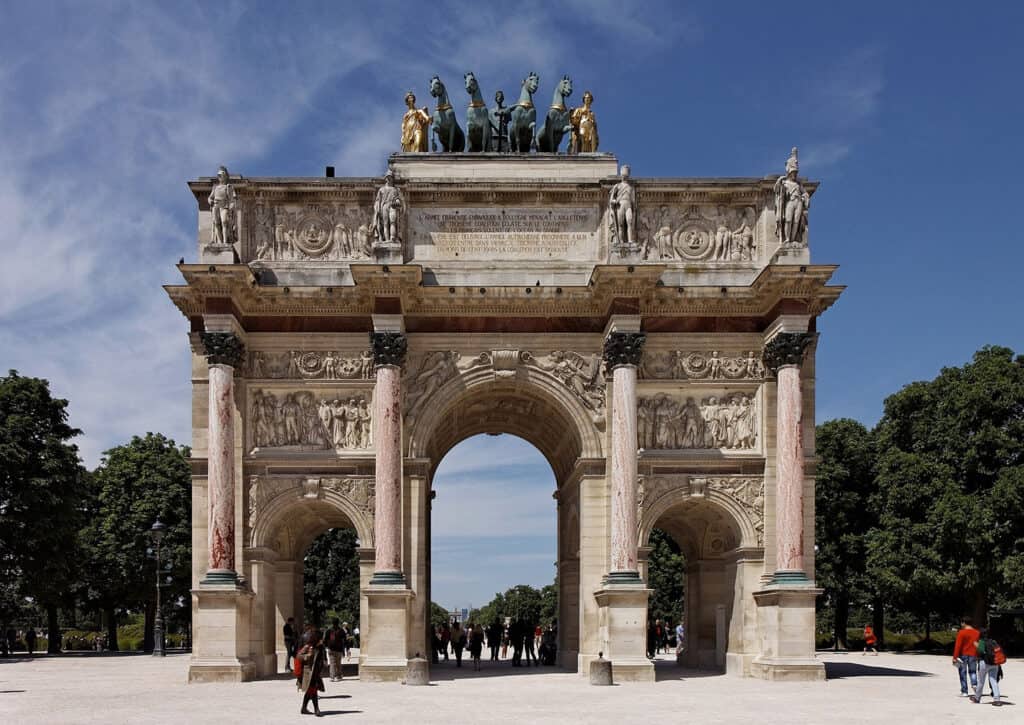
Neoclassical architecture arose in the mid-18th century as a response to the elaborate Baroque and Rococo styles. It favored simple, symmetrical designs inspired by ancient Greek and Roman buildings. Paris became a major hub for this style in Western Europe, featuring grand facades with classical elements like columns and pediments. Architects like Jacques-Germain Soufflot and Claude-Nicolas Ledoux were influential in shaping this aesthetic.
Characteristics:
- Symmetrical façades
- Columns and pilasters
- Pediments and entablatures
- Classical motifs like Greek keys and egg-and-dart patterns
- Use of high-quality materials like marble
Famous Examples:
- Panthéon in Paris: Designed by Jacques-Germain Soufflot. Its symmetrical layout, grand columns, domed roof, and detailed pediments, are inspired by ancient Greek and Roman design

- Brandenburg Gate in Berlin: Designed by Carl Gotthard Langhans, symbolizes Germany’s historical shifts and ideals of peace in a Neoclassical style.
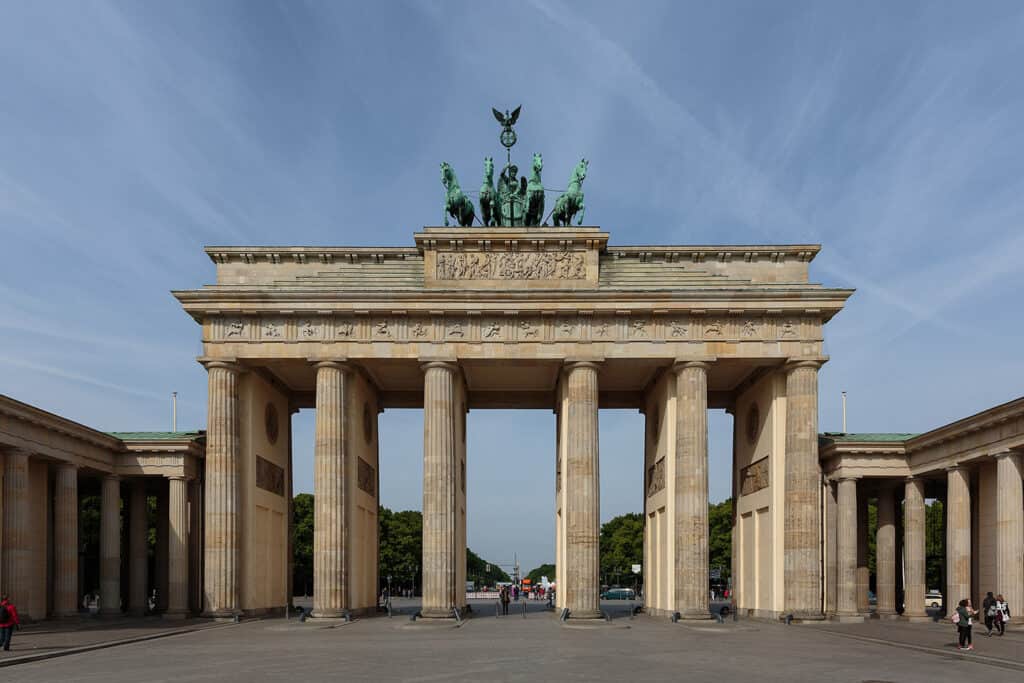
Legacy and Influence:
- Popular in 19th-century Europe and the United States, neoclassical architecture remains influential in contemporary design.
- Associated with Western society and prominent in European countries and South America.
- Notable architects include Robert Adam, John Soane, and Andrea Palladio, with extensive use in the Low Countries for various building types.
10. Art Nouveau
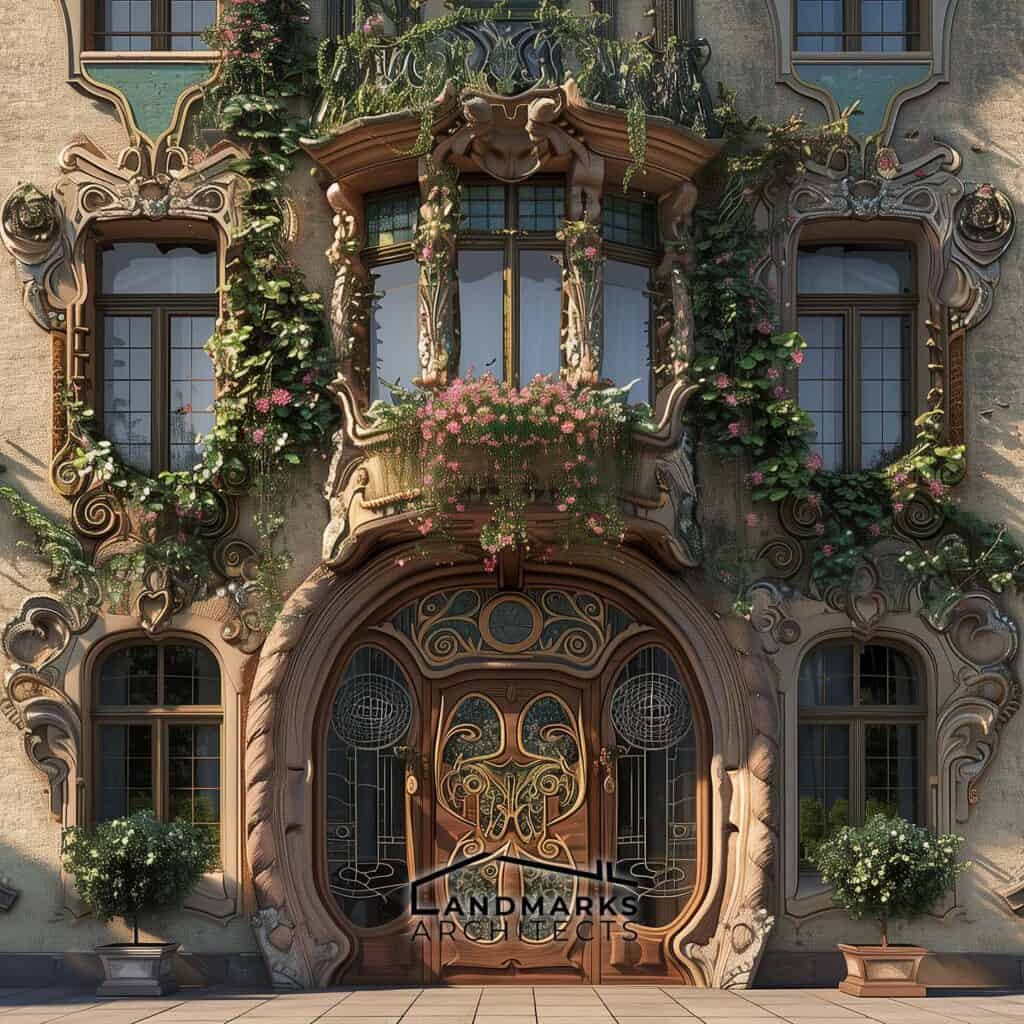
Art Nouveau, prevalent in Europe from around 1890 to the start of World War I, is an international style known for its organic shapes and elaborate ornamentation inspired by nature. It was more common in cities across Western and Central Europe, with Brussels being one of the most important cities associated with this style.
Characteristics:
- Long, sinuous lines and shapes
- Nature-inspired motifs like plants and flowers
- Elaborate ornamentation
- Use of geometric and oval shapes
- Sense of dynamism and movement
- Often innovative uses of iron and glass
Famous Examples:
- Hôtel Tassel in Brussels, Belgium: designed by architect Victor Horta in 1893, known for its curving lines, organic motifs, and innovative layout.
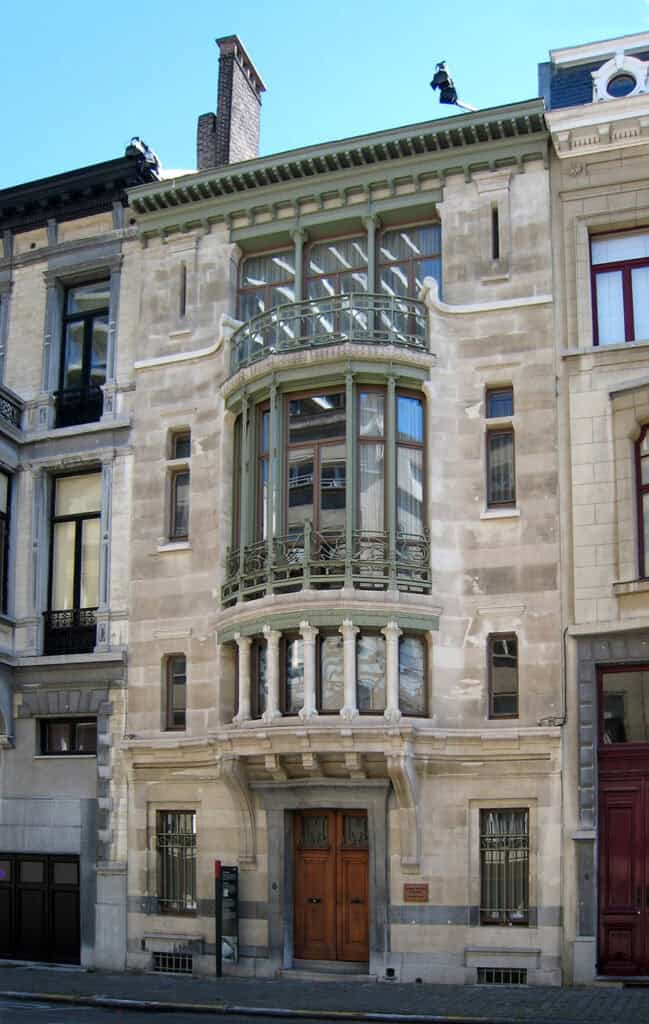
- Casa Batlló in Barcelona, Spain: Architect: Antoni Gaudí .This building is renowned for its skeletal-like structure, undulating facade, and vibrant colors. The design is inspired by natural marine life, with the roof resembling a dragon’s back.
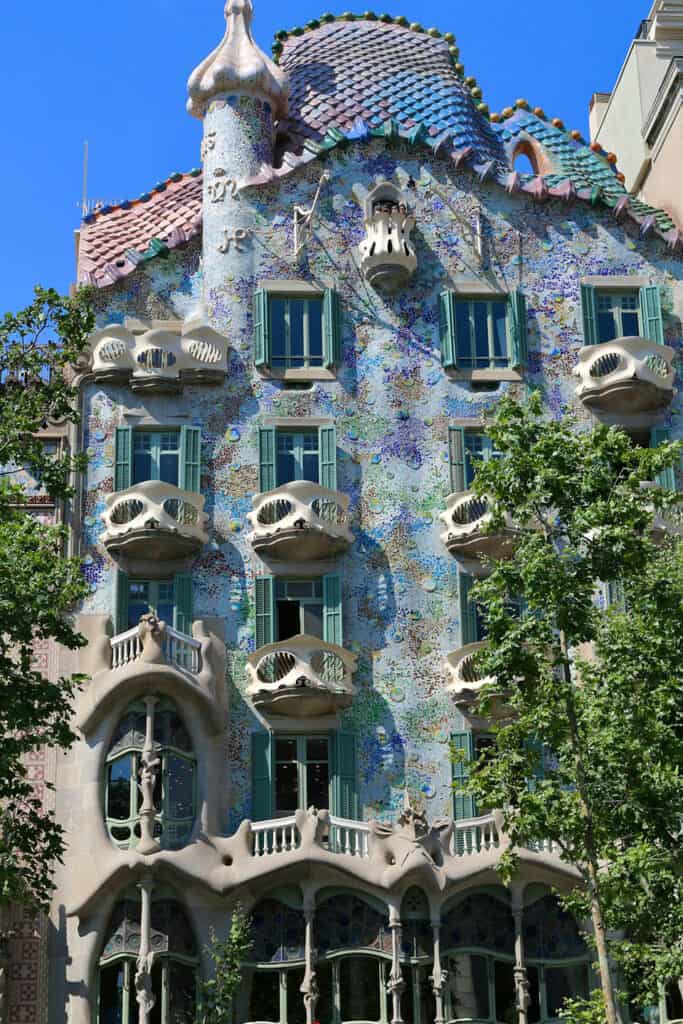
Art Nouveau marked a departure from traditional European styles, ushering in a new era of design with its emphasis on organic forms and ornamentation, influencing architects and designers for decades to come.
11. Art Deco
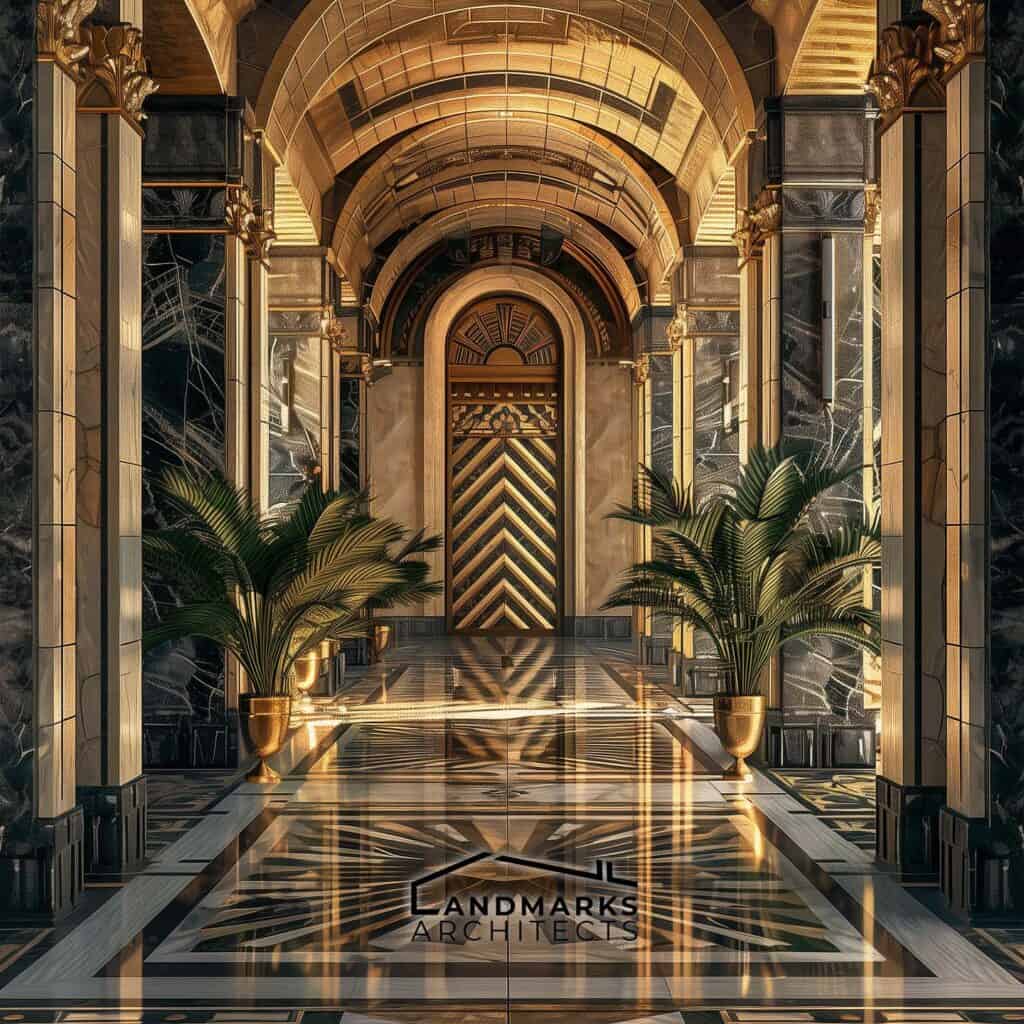
Art Deco, emerging in the 1920s and 1930s in Europe, is characterized by its geometric shapes, bold colors, and use of luxurious materials like marble and gold, reflecting the luxury and technological advancements of the time. Prominent in cities across Western Europe, Paris stands out as one of the most significant centers of this style.
Characteristics:
- Geometric shapes and patterns
- Bold, contrasting colors
- Emphasis on symmetry and balance
- Luxurious materials such as marble, gold, and chrome
- Decorative elements like sunbursts, zigzags, and stylized flora and fauna
Famous Examples:
- The Palais de Tokyo in Paris: was built in the 1930s, featuring streamlined forms, geometric motifs, and decorative elements.
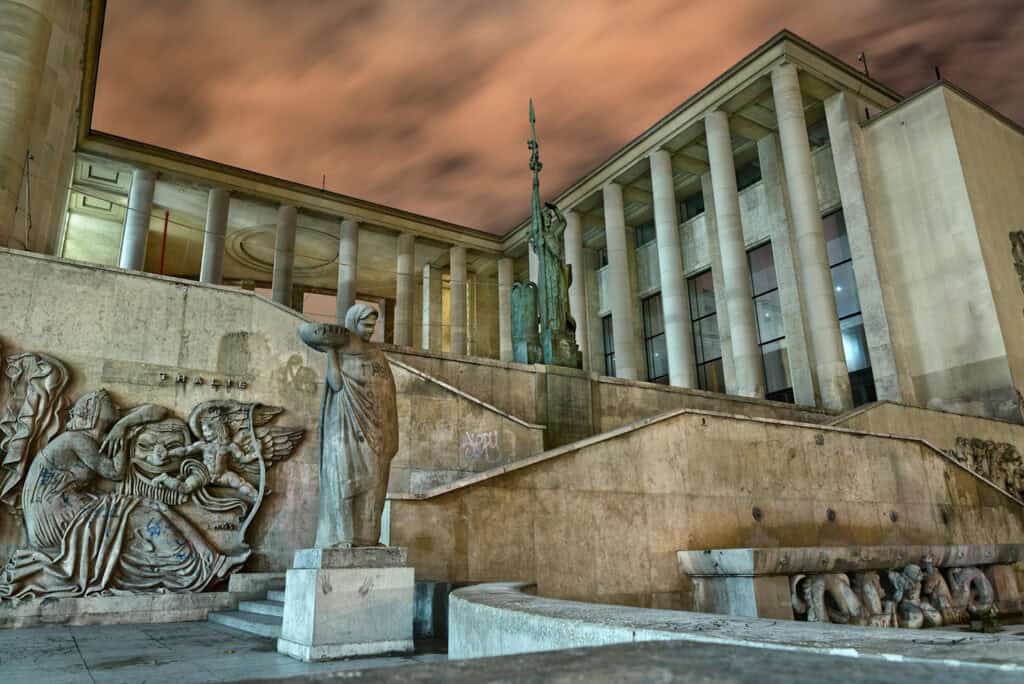
- The Chrysler Building (New York City): Completed in 1930, is a renowned skyscraper famous for its distinctive Art Deco style, featuring a stainless steel spire and intricate ornamentation with eagles and geometric patterns.
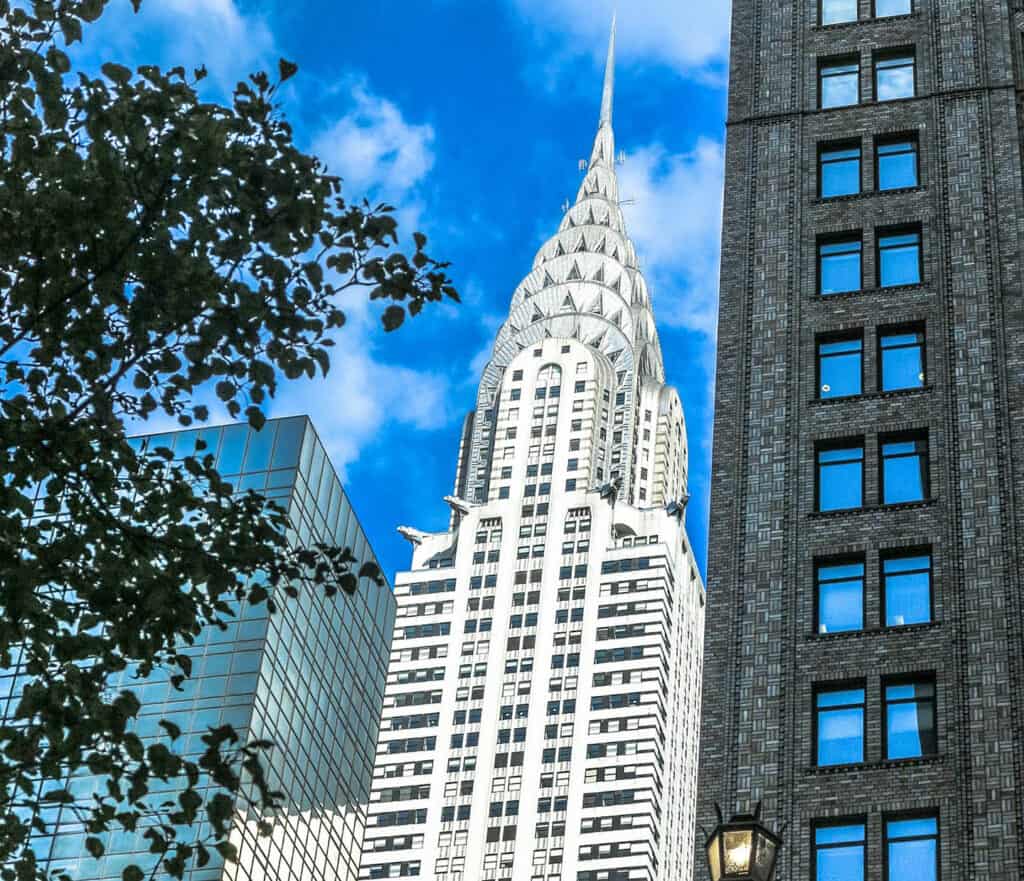
Art Deco‘s influence extended beyond architecture, shaping fashion, art, and jewelry. Its bold aesthetic remains influential in modern design, marking an important era in Western society’s history and architectural evolution.
12. Modernism and Bauhaus
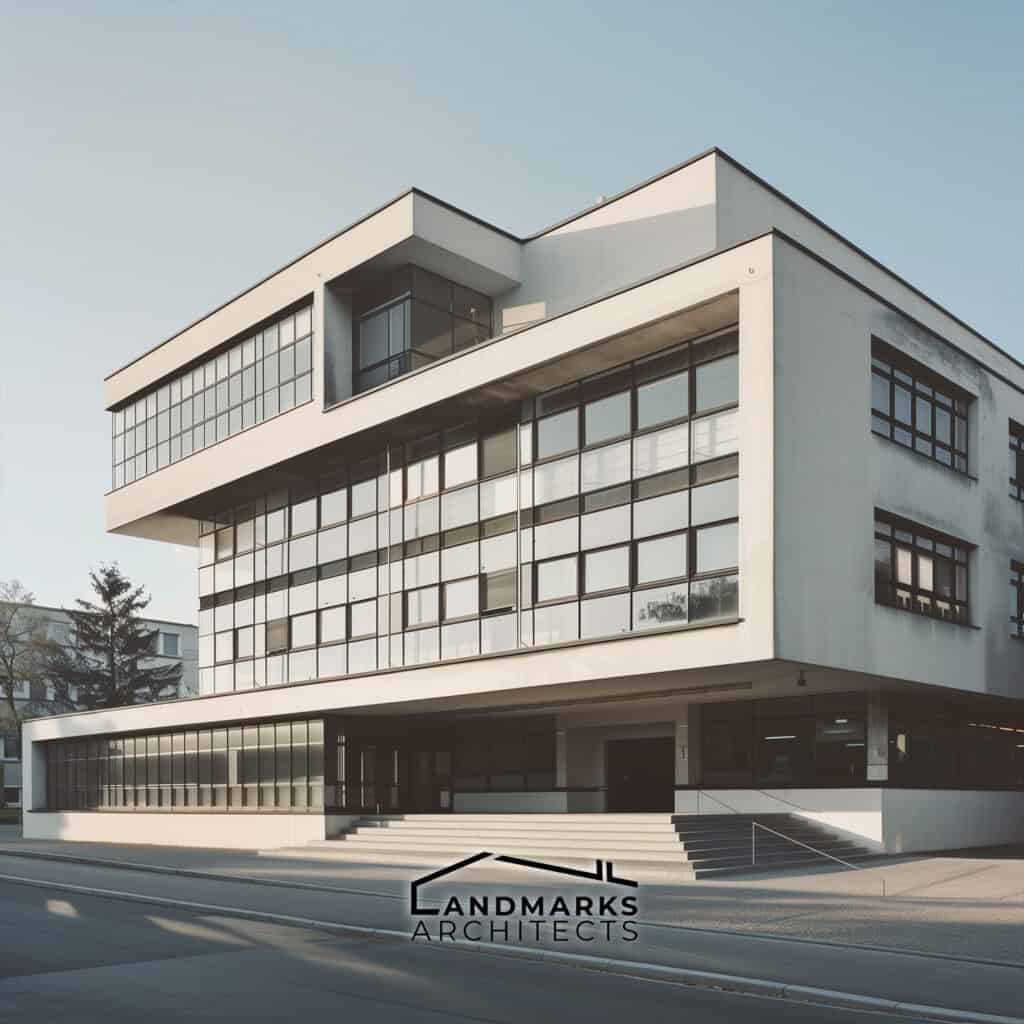
Modernism and Bauhaus emerged predominantly in cities across Germany, with Berlin being one of the most significant centers of this style. Modern architecture, responding to the industrial revolution and new materials, arose in the early 20th century. Among its influential styles is Bauhaus, originating in 1920s Germany.
Bauhaus Characteristics:
- Functional, rational, minimalist design
- Emphasis on industrial materials like glass, steel, and concrete
- Bauhaus integrated art, craft, and technology
Famous Examples:
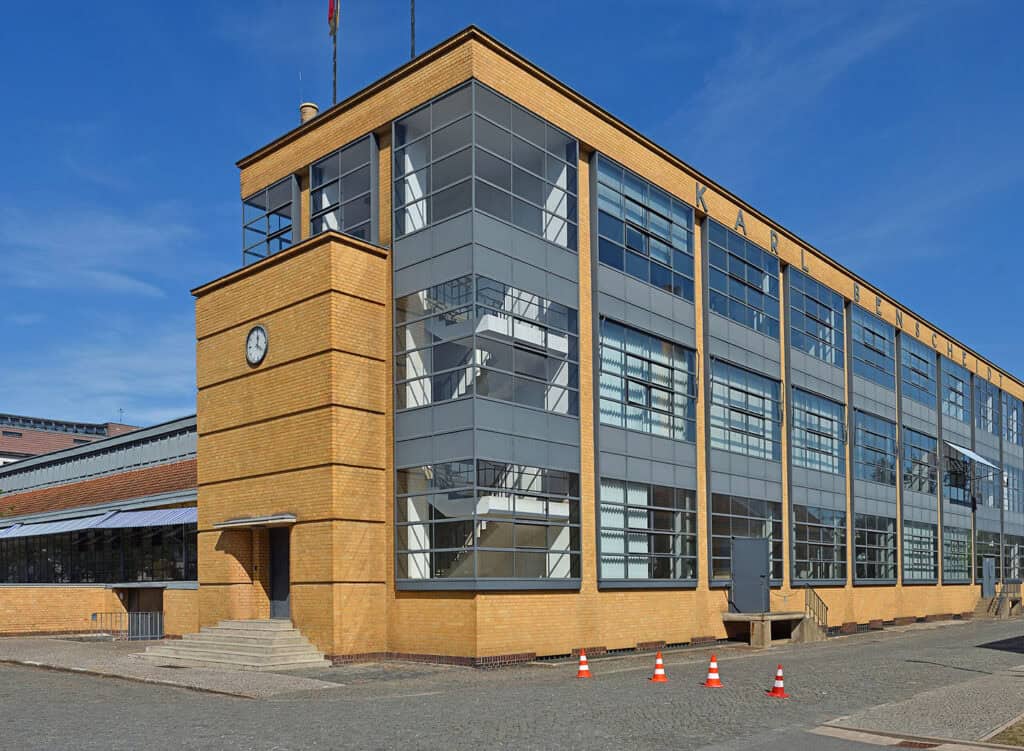
Bauhaus Dessau and Fagus Factory, both designed by Walter Gropius, embody the principles of functionalism, rationalism, and the innovative use of industrial materials that defined the Bauhaus movement.
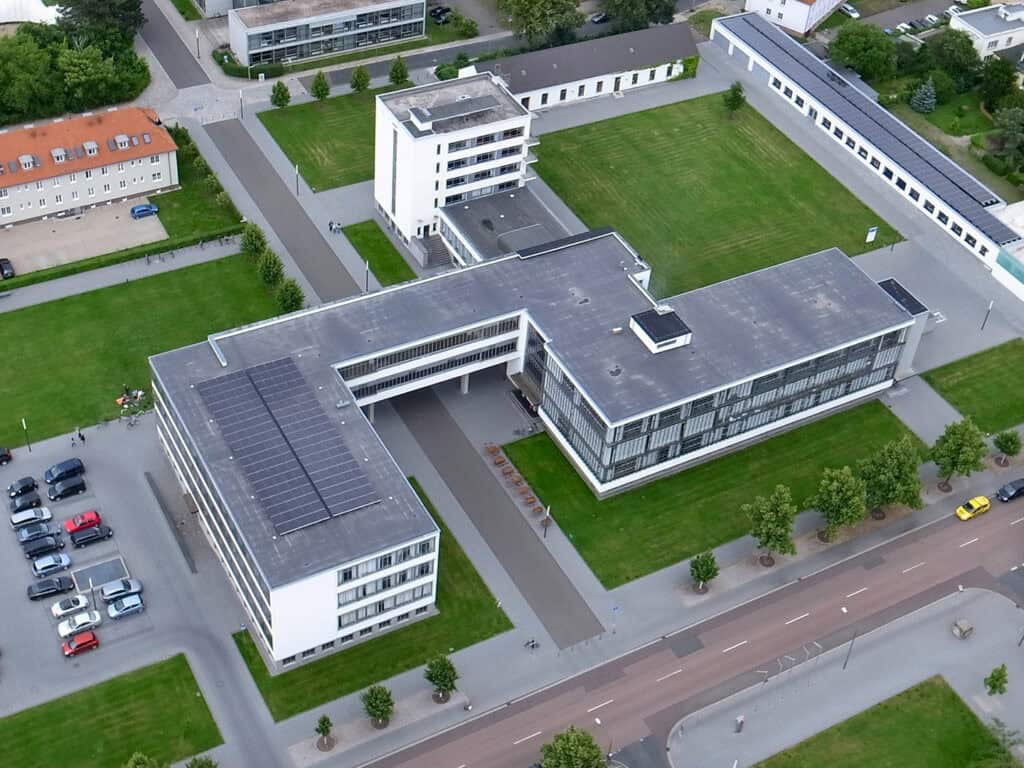
Post-War and Contemporary Architecture Styles

13. Brutalism
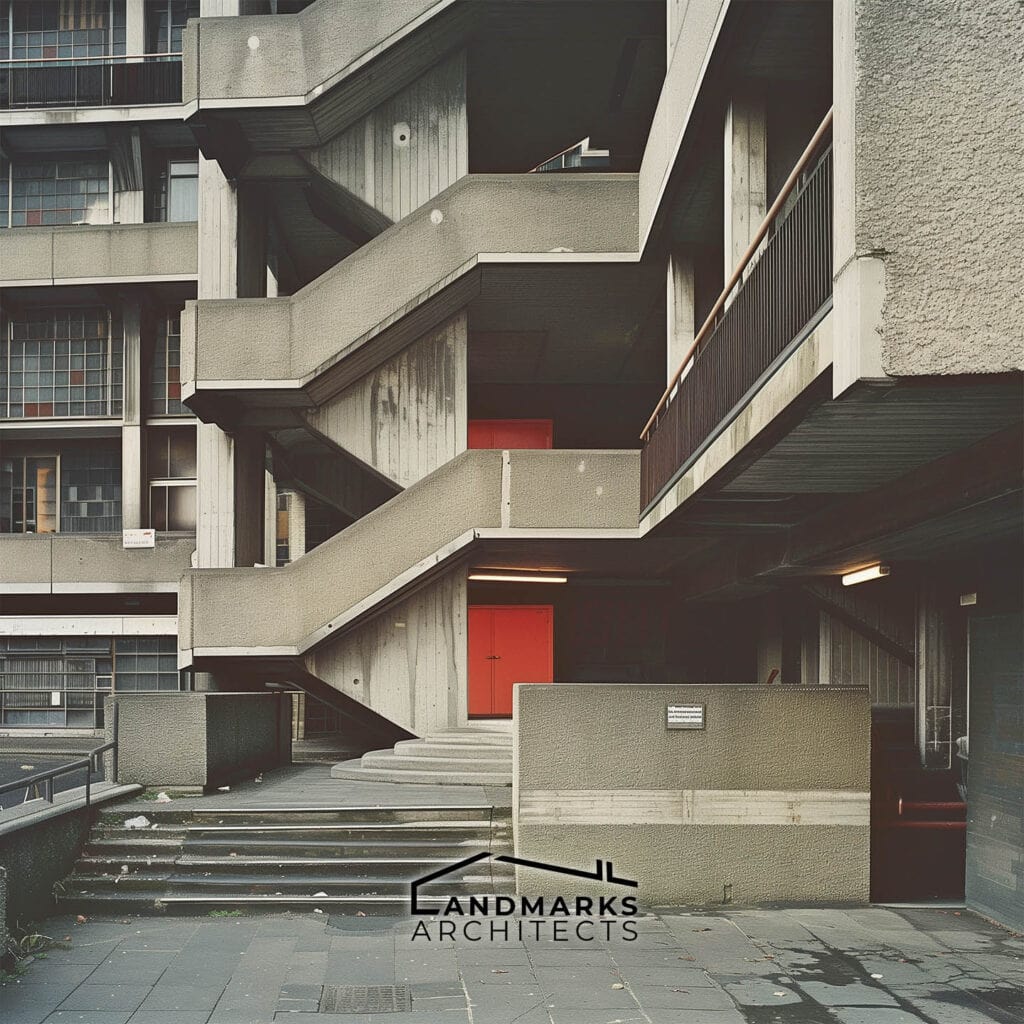
Brutalism, characterized by its raw concrete surfaces and blocky forms, was prevalent in cities across Western Europe, with London emerging as a notable hub of this architectural style in the early 1950s.
Characteristics:
- Bold and monumental scale
- Rough and unfinished surfaces
- Minimal ornamentation
- Emphasis on functionality
- Often used béton brut (raw concrete).
Famous Example:
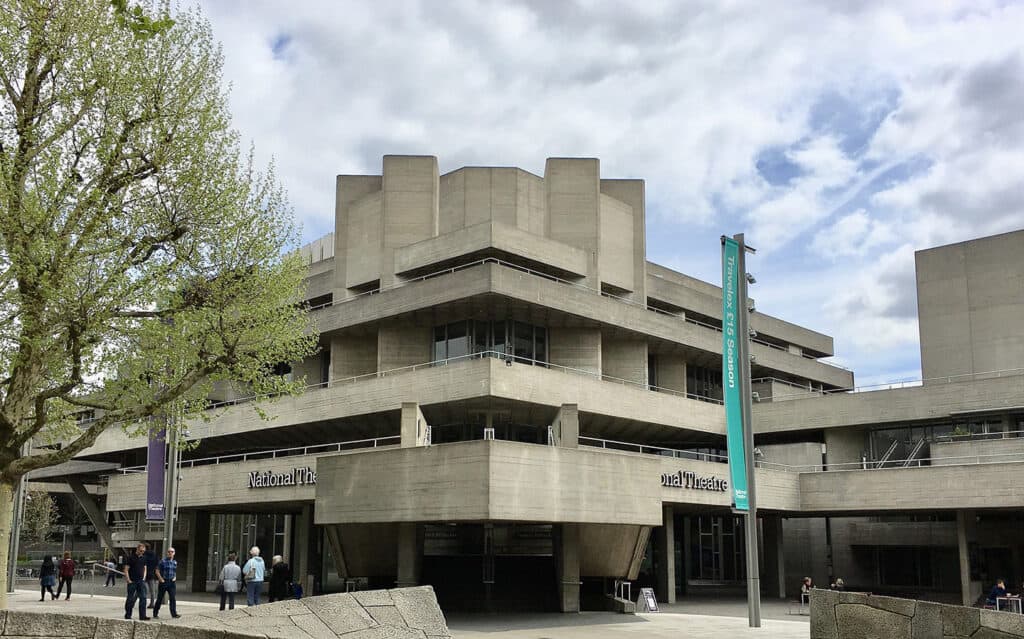
- Royal National Theatre in London, designed by Denys Lasdun, stands as a prominent example of Brutalism, showcasing rugged, raw concrete structures and a focus on bold geometric forms.
14. Deconstructivism
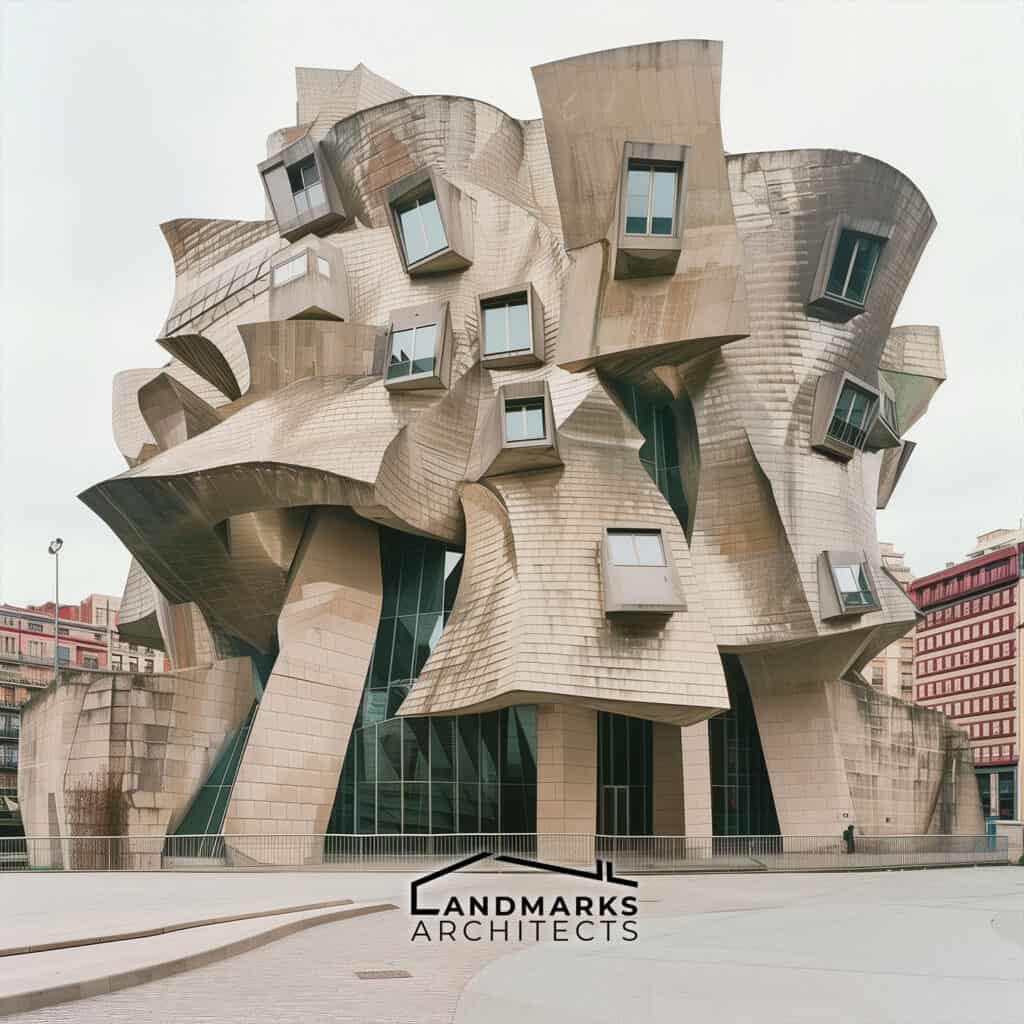
Deconstructivism, a postmodern architectural style characterized by fragmented forms and unconventional materials, found prominence in cities across Western Europe, with Bilbao in Spain emerging as a significant center of this innovative architectural movement in the late 1980s.
Characteristics:
- Fragmented and distorted forms
- Non-linear shapes
- Use of unconventional materials
- Emphasis on deconstruction and fragmentation
- Often challenges traditional architectural norms and aesthetics.
Famous Examples:
- The Guggenheim Museum Bilbao in Spain, designed by Frank Gehry, showcases striking Deconstructivist architecture with its dynamic forms and titanium exterior.
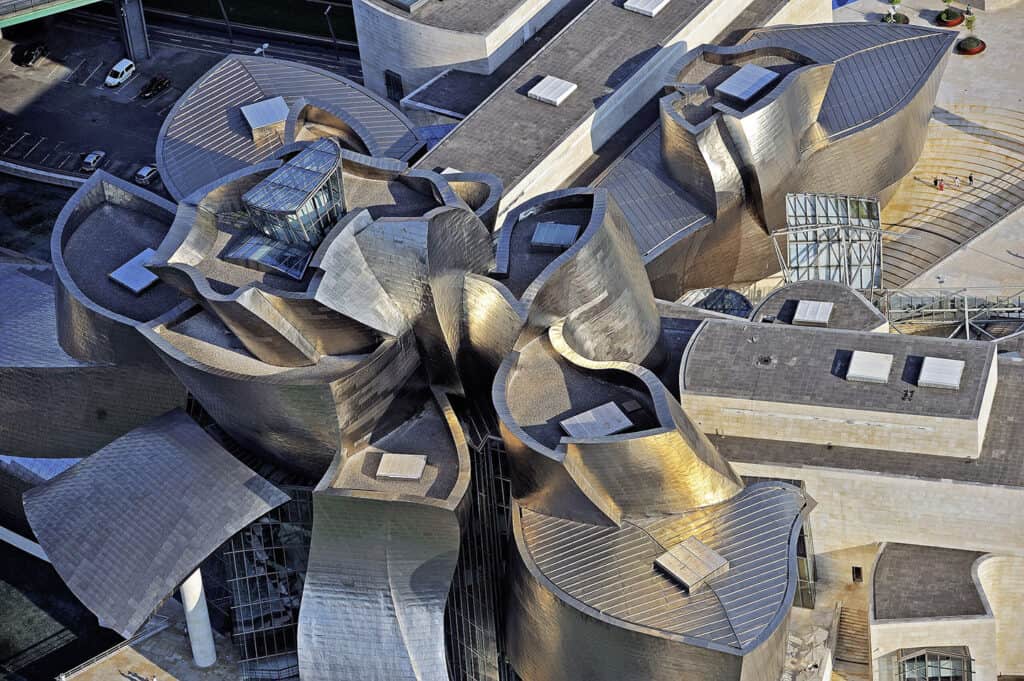
- Walt Disney Concert Hall in Los Angeles, designed by Frank Gehry, is an architectural marvel known for its sweeping stainless steel curves and innovative design, making it a cultural landmark and a masterpiece of contemporary architecture.
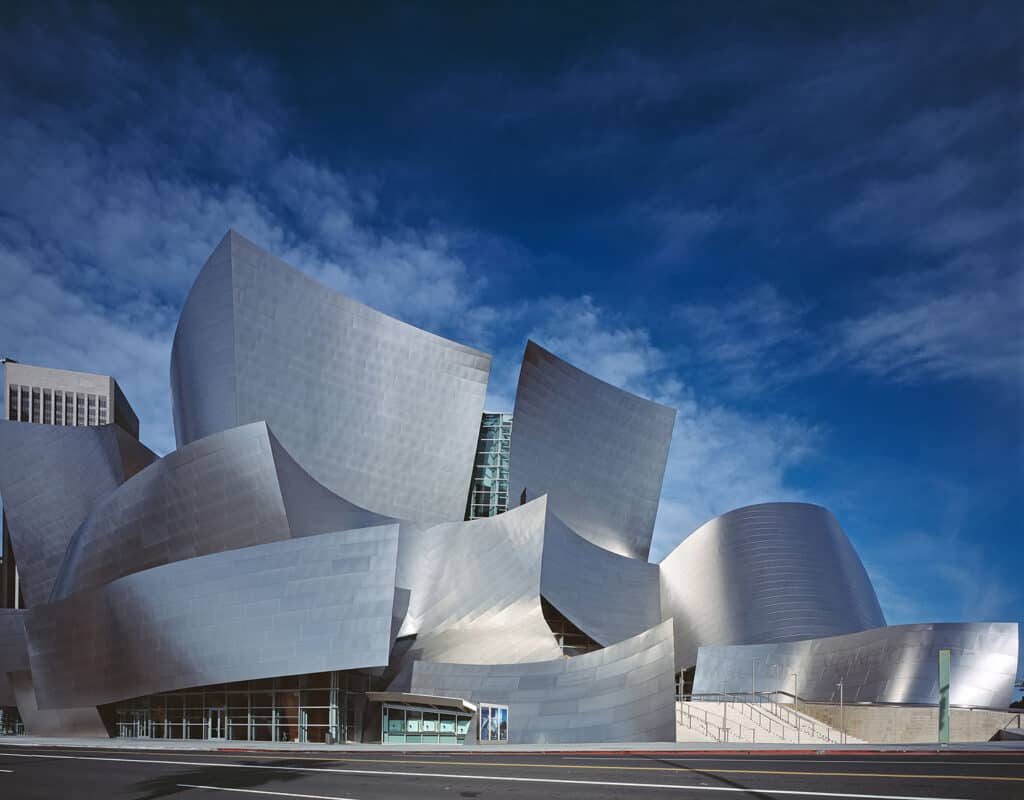
European-style architecture spans centuries, from the classical elegance of Greece and Rome to the medieval grandeur of cathedrals. Renaissance Revival, Baroque drama, and Neoclassical symmetry showcase its evolution. Modern movements like Art Nouveau, Art Deco, and Bauhaus embody bold experimentation within European-style architecture. Post-war periods witness Brutalism’s rawness and Deconstructivism‘s avant-garde forms, reflecting an ever-evolving tapestry of creativity and innovation within European-style architecture.










